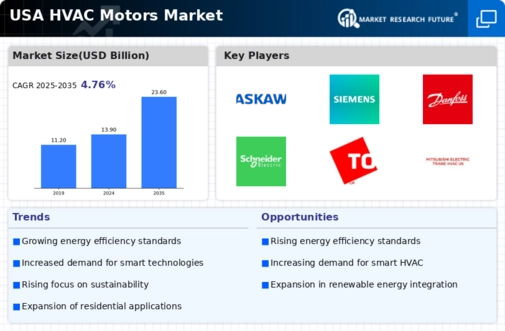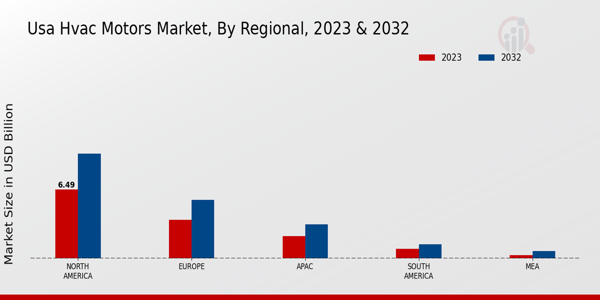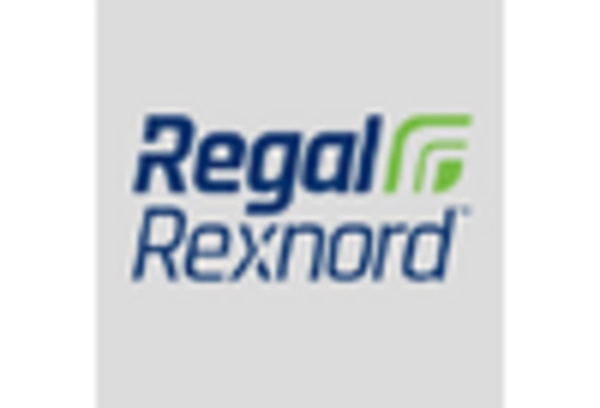Focus on Renewable Energy Integration
The shift towards renewable energy sources is influencing the hvac motors market in the US. As more consumers and businesses seek to incorporate solar and wind energy into their operations, the demand for HVAC systems that can efficiently utilize these energy sources is increasing. This trend is likely to drive innovation in motor technology, as manufacturers develop products that can operate effectively with renewable energy systems. The hvac motors market is projected to grow by 5% annually as the integration of renewable energy becomes more prevalent. This focus on sustainability not only aligns with environmental goals but also offers potential cost savings for consumers, further enhancing the appeal of energy-efficient hvac solutions.
Technological Advancements in Motor Design
Innovations in motor design are playing a crucial role in shaping the hvac motors market. The introduction of brushless DC motors and electronically commutated motors (ECMs) has led to improved efficiency and performance. These advanced motors are designed to operate at lower noise levels while consuming less energy, which aligns with the growing demand for energy-efficient solutions. The hvac motors market is expected to witness a growth rate of approximately 6% annually as manufacturers adopt these technologies. Furthermore, the integration of variable speed drives allows for better control of airflow, enhancing system performance and user comfort. As technology continues to evolve, the hvac motors market is likely to benefit from ongoing innovations that cater to both efficiency and user experience.
Rising Demand for Indoor Air Quality Solutions
The increasing awareness of indoor air quality (IAQ) is driving the hvac motors market. Consumers are becoming more conscious of the health implications associated with poor air quality, leading to a surge in demand for HVAC systems equipped with advanced motors that enhance air circulation and filtration. According to recent data, the market for air quality solutions is projected to grow at a CAGR of 8.5% through 2027. This trend indicates a significant opportunity for manufacturers of hvac motors to innovate and provide solutions that meet the evolving needs of consumers. Enhanced IAQ not only improves comfort but also contributes to better health outcomes, thereby reinforcing the importance of efficient hvac motors in residential and commercial applications.
Increased Construction Activities and Renovations
The ongoing expansion of the construction sector in the US is significantly impacting the HVAC motors market. With a projected increase in residential and commercial building projects, the demand for efficient HVAC systems is expected to rise correspondingly. According to the US Census Bureau, construction spending is anticipated to reach $1.5 trillion by 2026, which will likely drive the need for high-performance hvac motors. Renovation projects also contribute to this demand, as older systems are replaced with modern, energy-efficient alternatives. This trend not only supports the growth of the hvac motors market but also encourages manufacturers to focus on developing products that meet the latest building codes and energy standards.
Government Incentives for Energy Efficiency Upgrades
Government initiatives aimed at promoting energy efficiency are significantly impacting the hvac motors market. Various federal and state programs offer financial incentives for upgrading to energy-efficient HVAC systems, which often include advanced motors. These incentives can reduce the upfront costs for consumers, making it more feasible to invest in high-efficiency systems. As a result, the hvac motors market is likely to experience increased demand, with projections indicating a growth rate of around 7% over the next few years. Such government support not only encourages consumers to adopt more efficient technologies but also stimulates innovation within the industry, as manufacturers strive to meet the evolving standards and consumer expectations.


















Leave a Comment